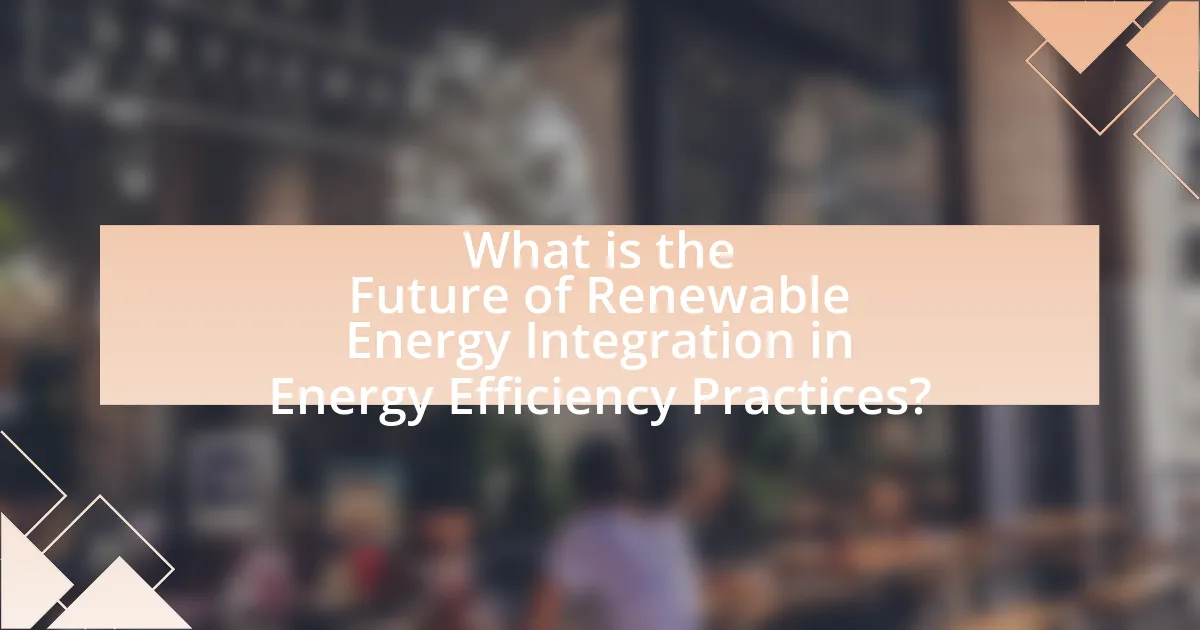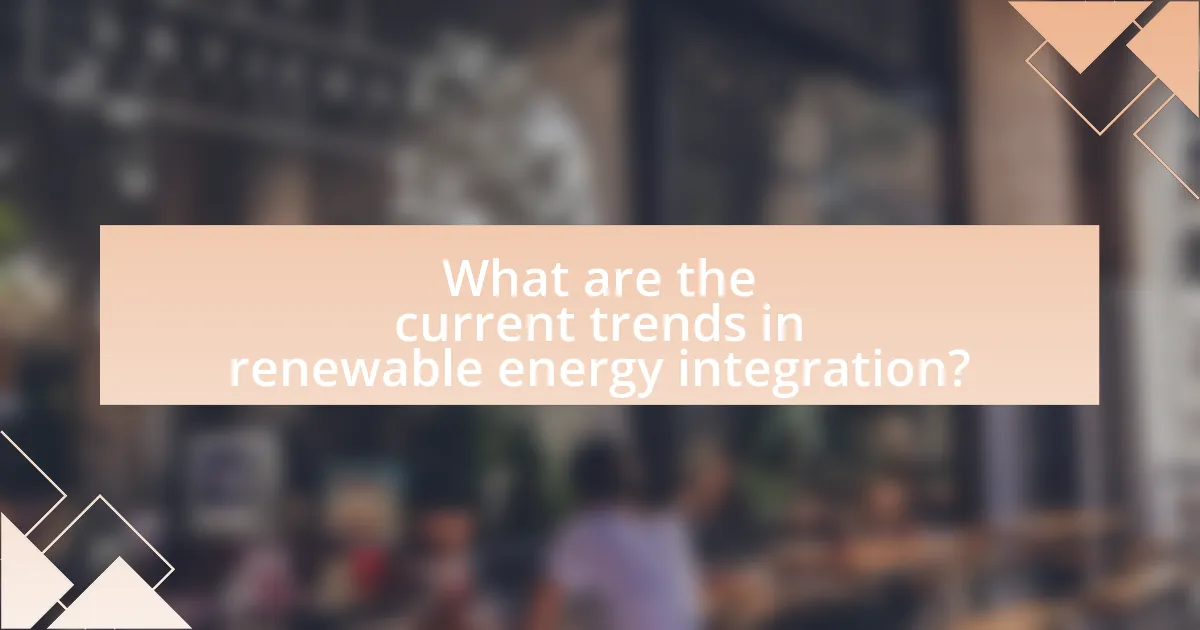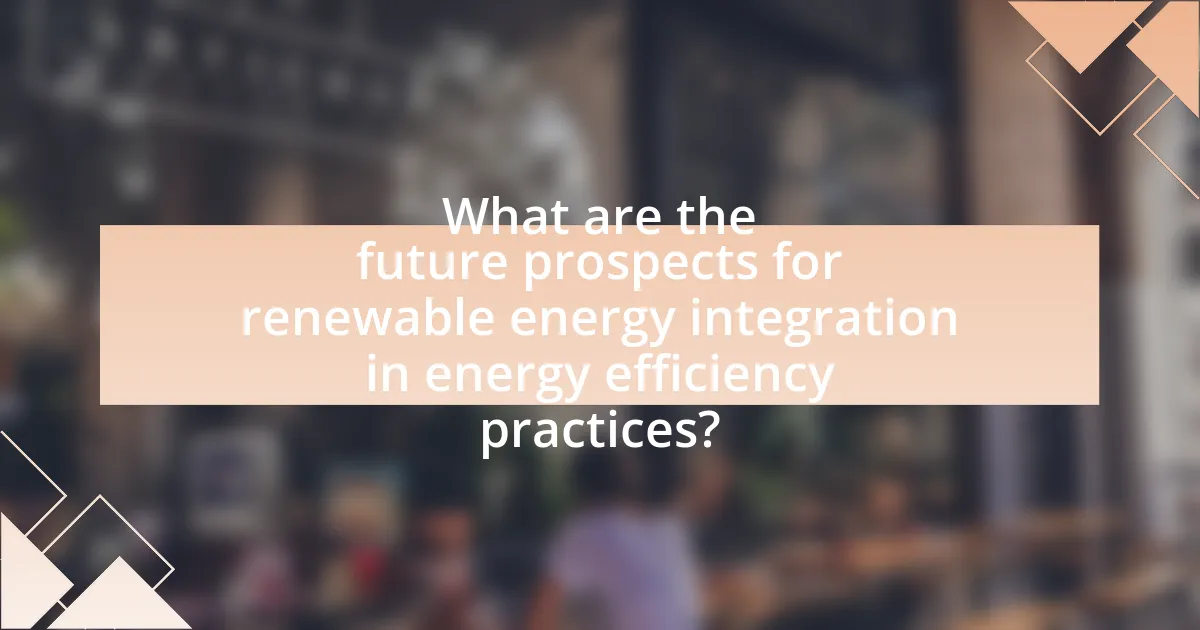The article focuses on the future of renewable energy integration within energy efficiency practices, emphasizing the role of smart technologies and decentralized energy systems. It outlines how integrating renewable sources such as solar and wind can enhance energy performance, reduce carbon emissions, and promote sustainability. Key technologies discussed include smart grids, energy storage systems, and demand response technologies, which collectively improve energy management and efficiency. The article also addresses current trends, government policies, challenges, and the importance of financial incentives in facilitating the adoption of renewable energy solutions. Overall, it highlights the significant potential for renewable energy integration to contribute to sustainable development and energy security.

What is the Future of Renewable Energy Integration in Energy Efficiency Practices?
The future of renewable energy integration in energy efficiency practices is characterized by increased reliance on smart technologies and decentralized energy systems. As governments and organizations prioritize sustainability, the integration of renewable sources like solar and wind into energy efficiency practices will enhance overall energy performance and reduce carbon footprints. For instance, the International Energy Agency projects that renewable energy could account for 80% of global electricity by 2050, driving innovations in energy management systems that optimize energy use in real-time. This shift will facilitate the development of smart grids, which enable better demand response and energy storage solutions, ultimately leading to more resilient and efficient energy systems.
How does renewable energy integration enhance energy efficiency?
Renewable energy integration enhances energy efficiency by optimizing energy use and reducing waste through decentralized energy generation. When renewable sources like solar and wind are integrated into the energy grid, they allow for localized energy production, which minimizes transmission losses associated with long-distance electricity transport. According to the International Renewable Energy Agency (IRENA), integrating renewables can lead to a reduction in energy consumption by up to 30% in certain sectors, as it encourages the use of energy-efficient technologies and practices. This shift not only lowers overall energy demand but also promotes the adoption of smart grid technologies that further enhance efficiency by managing energy supply and demand in real-time.
What are the key technologies involved in this integration?
The key technologies involved in the integration of renewable energy into energy efficiency practices include smart grids, energy storage systems, and demand response technologies. Smart grids enable real-time monitoring and management of energy distribution, enhancing efficiency and reliability. Energy storage systems, such as batteries, allow for the storage of excess renewable energy for later use, addressing intermittency issues. Demand response technologies facilitate the adjustment of consumer energy usage in response to supply conditions, optimizing energy consumption. These technologies collectively support the transition to a more sustainable energy system by improving the integration of renewable sources and enhancing overall energy efficiency.
How do these technologies improve overall energy performance?
Technologies improve overall energy performance by enhancing efficiency, reducing waste, and optimizing energy use. For instance, smart grid technologies enable real-time monitoring and management of energy consumption, leading to a reduction in peak demand and improved load balancing. According to the U.S. Department of Energy, smart grid implementations can reduce energy consumption by up to 20% through better demand response and energy management practices. Additionally, renewable energy technologies, such as solar panels and wind turbines, provide cleaner energy sources that decrease reliance on fossil fuels, further improving energy performance by lowering greenhouse gas emissions. The integration of energy storage systems also allows for better utilization of renewable energy, ensuring that excess energy generated during peak production times can be stored and used later, thus maximizing overall energy efficiency.
Why is renewable energy integration important for sustainable development?
Renewable energy integration is crucial for sustainable development because it reduces greenhouse gas emissions and promotes energy security. By incorporating renewable sources like solar, wind, and hydroelectric power, countries can decrease their reliance on fossil fuels, which are major contributors to climate change. For instance, a study by the International Renewable Energy Agency (IRENA) found that transitioning to renewable energy could reduce global CO2 emissions by up to 70% by 2050. This shift not only mitigates environmental impacts but also fosters economic growth through job creation in the renewable sector, enhancing overall societal resilience.
What role does it play in reducing carbon emissions?
Renewable energy plays a crucial role in reducing carbon emissions by providing cleaner alternatives to fossil fuels. By harnessing sources such as solar, wind, and hydroelectric power, renewable energy systems generate electricity with minimal or no greenhouse gas emissions. For instance, according to the International Renewable Energy Agency (IRENA), transitioning to renewable energy could reduce global carbon dioxide emissions by up to 70% by 2050. This significant reduction is achieved as renewable energy technologies replace carbon-intensive energy sources, thereby contributing to climate change mitigation and promoting sustainable energy practices.
How does it contribute to energy security and independence?
Renewable energy contributes to energy security and independence by reducing reliance on imported fossil fuels. By harnessing local resources such as solar, wind, and hydroelectric power, countries can generate their own energy, thereby enhancing their energy autonomy. For instance, according to the International Renewable Energy Agency (IRENA), the global share of renewable energy in total final energy consumption reached 18.1% in 2019, indicating a significant shift towards self-sufficiency. This transition not only mitigates the risks associated with geopolitical tensions and price volatility in fossil fuel markets but also promotes sustainable economic growth and job creation in the renewable sector.

What are the current trends in renewable energy integration?
Current trends in renewable energy integration include the increasing adoption of decentralized energy systems, enhanced energy storage solutions, and the integration of smart grid technologies. Decentralized energy systems, such as rooftop solar panels and community wind projects, allow for localized energy production, reducing transmission losses and increasing resilience. Enhanced energy storage solutions, like lithium-ion batteries and pumped hydro storage, are crucial for balancing supply and demand, enabling the use of intermittent renewable sources like solar and wind. Smart grid technologies facilitate real-time monitoring and management of energy resources, improving efficiency and reliability. According to the International Energy Agency, global renewable energy capacity reached 3,064 gigawatts in 2020, reflecting a 10% increase from the previous year, underscoring the rapid growth and integration of renewable energy sources into the energy mix.
How are governments and organizations promoting renewable energy practices?
Governments and organizations are promoting renewable energy practices through policies, incentives, and investments in clean energy technologies. For instance, many countries have implemented feed-in tariffs and tax credits to encourage the adoption of solar and wind energy. According to the International Renewable Energy Agency (IRENA), global renewable energy capacity reached 2,799 gigawatts in 2020, largely driven by supportive government policies. Additionally, organizations like the United Nations are facilitating international agreements, such as the Paris Agreement, which aims to limit global warming and promote sustainable energy solutions. These efforts collectively enhance the transition to renewable energy sources and improve energy efficiency practices.
What policies are being implemented to support this integration?
Policies being implemented to support the integration of renewable energy into energy efficiency practices include financial incentives, regulatory frameworks, and technological standards. Financial incentives, such as tax credits and grants, encourage investments in renewable technologies, while regulatory frameworks establish guidelines for energy efficiency standards that utilities must meet. For instance, the U.S. Department of Energy’s Energy Efficiency and Conservation Block Grant Program provides funding to local governments to implement energy efficiency projects, thereby facilitating the integration of renewable energy sources. Additionally, policies promoting smart grid technologies enhance the ability to manage and distribute renewable energy effectively, ensuring that energy efficiency practices are aligned with sustainable energy goals.
How do financial incentives impact renewable energy adoption?
Financial incentives significantly enhance renewable energy adoption by reducing the initial cost barriers for consumers and businesses. These incentives, such as tax credits, rebates, and grants, make renewable technologies like solar and wind more financially viable. For instance, the U.S. federal solar tax credit allows homeowners to deduct a percentage of the installation costs from their federal taxes, which has led to a substantial increase in solar installations—over 97% growth from 2010 to 2020, according to the Solar Energy Industries Association. Additionally, studies show that states offering robust financial incentives experience higher rates of renewable energy deployment, demonstrating a direct correlation between financial support and adoption rates.
What challenges are faced in integrating renewable energy into energy efficiency practices?
Integrating renewable energy into energy efficiency practices faces several challenges, including technological compatibility, regulatory barriers, and financial constraints. Technological compatibility issues arise when existing energy systems are not designed to accommodate renewable sources, leading to inefficiencies. Regulatory barriers often include outdated policies that do not incentivize or support the adoption of renewable technologies, hindering progress. Financial constraints can limit investment in necessary infrastructure upgrades and innovations, as many organizations may lack the capital to transition to more efficient systems. According to a report by the International Renewable Energy Agency, these challenges can significantly slow down the adoption of renewable energy solutions, impacting overall energy efficiency improvements.
What are the technical barriers to effective integration?
The technical barriers to effective integration of renewable energy into energy efficiency practices include interoperability issues, data management challenges, and inadequate infrastructure. Interoperability issues arise when different systems and technologies cannot communicate effectively, hindering seamless integration. Data management challenges stem from the vast amounts of data generated by renewable energy sources, which require advanced analytics and storage solutions to optimize performance. Inadequate infrastructure, such as outdated grid systems, limits the ability to accommodate distributed energy resources, making it difficult to fully leverage renewable energy potential. These barriers have been documented in studies, such as the International Renewable Energy Agency’s report on renewable energy integration, which highlights the need for improved technology and infrastructure to enhance efficiency and reliability in energy systems.
How do market dynamics affect the adoption of renewable energy solutions?
Market dynamics significantly influence the adoption of renewable energy solutions by shaping supply, demand, and pricing structures. For instance, fluctuations in fossil fuel prices can either incentivize or hinder the transition to renewables; when fossil fuel prices rise, renewable energy becomes more competitive, leading to increased adoption. Additionally, government policies and incentives, such as tax credits and subsidies, can create favorable market conditions that encourage investment in renewable technologies. According to the International Renewable Energy Agency (IRENA), global renewable energy capacity increased by 10.3% in 2020, driven by supportive policies and decreasing technology costs, illustrating how market dynamics can facilitate growth in this sector.

What are the future prospects for renewable energy integration in energy efficiency practices?
The future prospects for renewable energy integration in energy efficiency practices are highly promising, driven by technological advancements and supportive policies. As of 2023, the global renewable energy capacity has reached over 3,000 gigawatts, with solar and wind energy leading the growth, indicating a strong trend towards integrating these sources into energy efficiency frameworks. Research from the International Renewable Energy Agency (IRENA) shows that combining renewable energy with energy efficiency measures can reduce global energy demand by up to 30% by 2030, enhancing overall system performance and sustainability. This integration not only lowers greenhouse gas emissions but also leads to significant cost savings for consumers and businesses, reinforcing the viability of renewable energy in future energy efficiency practices.
How will advancements in technology shape this integration?
Advancements in technology will significantly enhance the integration of renewable energy into energy efficiency practices by improving energy management systems and enabling real-time data analytics. For instance, smart grid technologies facilitate better communication between energy producers and consumers, optimizing energy distribution and consumption. According to a report by the International Energy Agency, the implementation of smart grids can reduce energy losses by up to 30%, demonstrating the tangible benefits of technological advancements in this field. Additionally, innovations in energy storage, such as lithium-ion batteries, allow for more effective storage of renewable energy, ensuring a stable supply even when production fluctuates. This integration of advanced technologies not only increases the efficiency of energy systems but also supports the transition to a more sustainable energy future.
What emerging technologies are expected to play a significant role?
Emerging technologies expected to play a significant role in the future of renewable energy integration include artificial intelligence (AI), blockchain, and advanced energy storage systems. AI enhances energy management by optimizing consumption patterns and predicting energy demand, which is crucial for integrating renewable sources like solar and wind. Blockchain technology facilitates transparent and secure energy transactions, enabling peer-to-peer energy trading and improving grid resilience. Advanced energy storage systems, such as lithium-ion batteries and emerging solid-state batteries, are essential for storing intermittent renewable energy, ensuring a stable supply. These technologies collectively support the transition to a more efficient and sustainable energy landscape.
How can smart grid systems enhance renewable energy integration?
Smart grid systems enhance renewable energy integration by enabling real-time monitoring and management of energy resources. These systems utilize advanced communication technologies to facilitate the efficient distribution of electricity generated from renewable sources, such as solar and wind. For instance, smart grids can dynamically balance supply and demand, allowing for greater penetration of intermittent renewable energy sources into the grid. According to the U.S. Department of Energy, smart grid technologies can increase the integration of renewable energy by up to 30% by improving grid reliability and reducing operational costs. This capability is crucial for accommodating the variable nature of renewable energy generation, thus promoting a more sustainable energy future.
What best practices can organizations adopt for effective integration?
Organizations can adopt several best practices for effective integration of renewable energy into energy efficiency practices. Firstly, they should implement a comprehensive energy management system that enables real-time monitoring and analysis of energy consumption, which has been shown to reduce energy costs by up to 20% (U.S. Department of Energy). Secondly, fostering collaboration among stakeholders, including energy providers, regulators, and consumers, enhances communication and aligns goals, leading to more cohesive integration efforts. Thirdly, investing in training and development for employees ensures that staff are equipped with the necessary skills to manage and optimize renewable energy systems effectively. Additionally, organizations should prioritize the use of standardized protocols and technologies to facilitate interoperability between different energy systems, which can streamline operations and reduce integration costs. Lastly, conducting regular assessments and audits of energy systems helps identify areas for improvement and ensures that integration strategies remain effective and aligned with evolving technologies and regulations.
How can businesses measure the success of their energy efficiency initiatives?
Businesses can measure the success of their energy efficiency initiatives by analyzing key performance indicators (KPIs) such as energy consumption reduction, cost savings, and return on investment (ROI). For instance, a study by the U.S. Department of Energy indicates that companies implementing energy efficiency measures can achieve energy savings of 20-30%, which directly correlates to reduced operational costs. Additionally, tracking metrics like payback period and energy intensity (energy use per unit of output) provides concrete data on the effectiveness of these initiatives. By comparing pre- and post-implementation energy usage and costs, businesses can quantitatively assess the impact of their energy efficiency strategies.
What strategies can be implemented to overcome integration challenges?
To overcome integration challenges in renewable energy, implementing a multi-faceted approach is essential. Strategies include enhancing grid infrastructure, adopting advanced energy management systems, and fostering collaboration among stakeholders. For instance, upgrading transmission lines and substations can facilitate the integration of distributed energy resources, as evidenced by studies showing that improved grid capacity can increase renewable energy adoption by up to 30%. Additionally, utilizing smart grid technologies allows for real-time monitoring and management of energy flows, which can optimize the use of renewable sources. Collaborative efforts among government, industry, and communities can also streamline regulatory processes and promote shared resources, leading to more effective integration of renewable energy into existing systems.
What are the practical steps for individuals to support renewable energy integration?
Individuals can support renewable energy integration by adopting energy-efficient practices and utilizing renewable energy sources in their daily lives. This includes installing solar panels on their homes, which can reduce reliance on fossil fuels and lower electricity bills. Additionally, individuals can participate in community solar programs, allowing them to benefit from solar energy without needing to install panels themselves.
Moreover, individuals can reduce energy consumption by using energy-efficient appliances and implementing smart home technologies that optimize energy use. According to the U.S. Department of Energy, energy-efficient appliances can reduce energy use by 10-50%, contributing to overall energy savings and supporting renewable energy goals.
Furthermore, advocating for policies that promote renewable energy development and supporting local renewable energy projects can amplify individual efforts. Engaging in educational initiatives about renewable energy and its benefits can also foster community support for integration efforts.